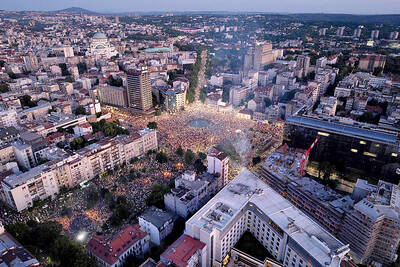The first space mission in over 10 years to Earth's closest neighbor Venus emitted its first signal yesterday after a successful launch from the Russian cosmodrome in Baikonur, Kazakhstan.
"The baby cried. Venus Express has begun its operational mission," said Jean-Pierre Cau, an official from EADS Astrium, the company that built the spacecraft's propulsion system, after receiving the signal.
Venus Express separated successfully from the Soyuz Fregat carrier rocket more than 90 minutes after its 03:33am launch at the start of a 163-day journey to Venus.
The European Space Agency's (ESA) first probe to the planet, Venus Express will explore its unusual stormy atmosphere and runaway global warming in the hope of better understanding Earth's greenhouse-gas problem.
Venus, the second planet from the Sun, is similar in size, mass and age to Earth but has a vastly different and ferociously hot weather system.
Also known as the Evening Star, thanks to the bright light it reflects from the Sun, the planet is blanketed by thick clouds of suffocating gas driven by often hurricane-force winds and a surface pressure and temperature high enough to crush and melt lead.
The planet's clouds reflect back 80 percent of the Sun's radiation and absorb another 10 percent, leaving just 10 percent to filter down to the surface.
But the clouds provide such effective insulation the surface zone becomes a pressure cooker capable of melting metal.
"Venus has no surface water, a toxic, heavy atmosphere made up almost entirely of carbon dioxide with clouds of sulfuric acid, and at the surface the atmospheric pressure is over 90 times that of Earth at sea-level," the ESA notes.
The planet's searing surface temperature of 477 Celsius -- the hottest in the Solar System -- and immense atmospheric pressure have caused many previous missions to fail or send data streams lasting only minutes before their instruments were crushed.
It is hoped, however, that the 1.27-tonne unmanned Venus Express orbiter will be able to use seven powerful instruments on board to map the planet's surface and weather system, looking at temperature variation, cloud formations, wind speeds and gas composition.
After a 163-day journey, the craft is scheduled to arrive off Venus in April, when it will be placed in an elliptical orbit, swooping to as low as 250km above the surface to a height of 66,000km.
The orbiter, whose total mission costs are US$264 million, has enough fuel to operate for 1,000 Earth days, the ESA says.
The first mission to Venus in 1961 saw a Soviet-made probe lose communications with ground control about 7 million kilometers from Earth.
The following year the US Mariner 2 became the first successful interplanetary mission.

Drug lord Jose Adolfo Macias Villamar, alias “Fito,” was Ecuador’s most-wanted fugitive before his arrest on Wednesday, more than a year after he escaped prison from where he commanded the country’s leading criminal gang. The former taxi driver turned crime boss became the prime target of law enforcement early last year after escaping from a prison in the southwestern port of Guayaquil. Ecuadoran President Daniel Noboa’s government released “wanted” posters with images of his face and offered US$1 million for information leading to his capture. In a country plagued by crime, members of Fito’s gang, Los Choneros, have responded with violence, using car

Two former Chilean ministers are among four candidates competing this weekend for the presidential nomination of the left ahead of November elections dominated by rising levels of violent crime. More than 15 million voters are eligible to choose today between former minister of labor Jeannette Jara, former minister of the interior Carolina Toha and two members of parliament, Gonzalo Winter and Jaime Mulet, to represent the left against a resurgent right. The primary is open to members of the parties within Chilean President Gabriel Boric’s ruling left-wing coalition and other voters who are not affiliated with specific parties. A recent poll by the

TENSIONS HIGH: For more than half a year, students have organized protests around the country, while the Serbian presaident said they are part of a foreign plot About 140,000 protesters rallied in Belgrade, the largest turnout over the past few months, as student-led demonstrations mount pressure on the populist government to call early elections. The rally was one of the largest in more than half a year student-led actions, which began in November last year after the roof of a train station collapsed in the northern city of Novi Sad, killing 16 people — a tragedy widely blamed on entrenched corruption. On Saturday, a sea of protesters filled Belgrade’s largest square and poured into several surrounding streets. The independent protest monitor Archive of Public Gatherings estimated the

Irish-language rap group Kneecap on Saturday gave an impassioned performance for tens of thousands of fans at the Glastonbury Festival despite criticism by British politicians and a terror charge for one of the trio. Liam Og O hAnnaidh, who performs under the stage name Mo Chara, has been charged under the UK’s Terrorism Act with supporting a proscribed organization for allegedly waving a Hezbollah flag at a concert in London in November last year. The rapper, who was charged under the anglicized version of his name, Liam O’Hanna, is on unconditional bail before a further court hearing in August. “Glastonbury,